
We kindly inform you that, as long as the subject affiliation of our 300.000+ articles is in progress, you might get unsufficient or no results on your third level or second level search. In this case, please broaden your search criteria.

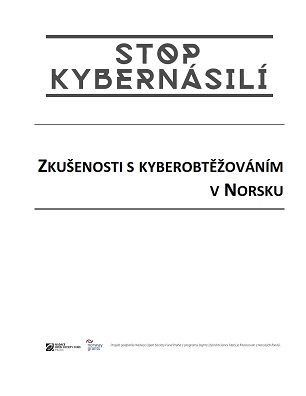


Anonymous users stole the show this quarter. Never before have we observed such high levels of activity from anonymous accounts. At the same time, bot activity in Russian-language conversations about NATO activity in the Baltics and Poland has emerged from its winter slumber. In the wake of the Skripal poisonings in the UK in March, Russian-language bot and anonymous activity about NATO more than doubled. Mentions of NATO on VK, in contrast, have been stable and declining during the whole period. Social media companies are working to end platform misuse. But malicious activity is evolving. Today, anonymous accounts are dominating the conversation. These accounts are either operated manually, or they have become advanced enough to fool human observers. The responses from open and free societies to the problem of online malicious activity have neither been strong enough, nor consistent enough. Figures presented in this issue reveal a disparity between the conversation quality in English and Russian-language spaces. Currently, the Russian-language conversation about NATO in the Baltics and Poland has six times the proportion of content from bot and anonymous accounts. As Twitter has taken steps to remove bots, the disparity has only widened. We assess that 93% of Russian-language accounts in our dataset are operated anonymously or automatically. In no way does this conversation mirror opinions of citizens. Journalists, policy makers, and advertisers take note!
More...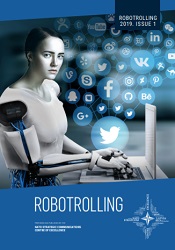
This report presents top-level findings from the first research project to systematically track and measure the scale of inauthentic activity on the Russian social network VK. On VK, a vocal core consisting of loyal news media, pro-Kremlin groups, and bots and trolls dominates the conversation about NATO. The volume of material from this core group is such, that overall genuine users account for only of 14% of the total number of messages about NATO in the Baltic States and Poland. The spread of demonstrably fake content can offer a starting point for measuring how social media manipulation impacts genuine conversations. In the case of one story about a fictitious Finnish blogger, our algorithm estimates that at least 80% of users who shared the fake story were authentic. This quarter, messages appeared in more than 2 000 different group pages on VK. Setting aside messages from group pages, 37% of VK posts came from ‘bot’ accounts—software that mimics human behavior online. This level of activity is comparable to what we have seen on Russian-language Twitter. Unlike on Twitter, where the vast majority of human-controlled accounts are operated anonymously, on VK most accounts are likely to be authentic. Western social media companies have belatedly taken an active role in reducing the reach of the Kremlin’s social media manipulation efforts. However, it remains hard for researchers to evaluate the effectiveness of these measures on platforms such as Facebook and Instagram. In this context, VK offers a cautionary view of a network with minimal privacy, regulation, and moderation.
More...
President Trump’s whirlwind tour of Europe in July provoked ferocious discussion about NATO on social media. Anonymous human-controlled English-language accounts, expressing positions in support of or in opposition to the US President, dominated online conversations. Compared to the levels observed in the Spring issue of Robotrolling, the volume of English-language messages has more than doubled. The increasing proportion of anonymous accounts active during key political moments indicate that anonymity is being abused to cloak manipulation on social networks. We call on social media companies to keep investing in countering platform misuse. The social media companies Reddit and Twitter have released lists of accounts identified as originating from the notorious St Petersburg ‘troll factory’—the Internet Research Agency (IRA). In this issue, we present the first quantitative analysis comparing English- and Russian-language posts from these accounts. The IRA bombarded citizens in Russia and its neighboring states with pro-Kremlin propaganda. For English, fake accounts posed as Trump supporters, and argued both sides of the Black Lives Matter controversy. Russian-language material closely echoed and amplified the narratives popularized by Russian state-media. Amongst the accounts identified by Twitter, 26 also posted about NATO in the Baltics and Poland. Our algorithm correctly identified 24 of these as bot accounts. The other two accounts were anonymous human-controlled (troll) accounts.
More...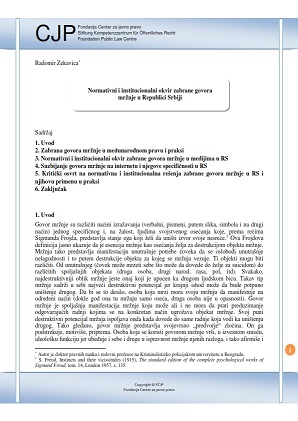
After analyzing the prohibition of hate speech in international law and practice, the author analyzes the normative and institutional framework for hate speech prohibition in Serbia. The analysis points to valid legal solutions to this prohibition, regulations of regulatory bodies that are responsible for combating hate speech in print and electronic media and the Internet, and then provides an overview of institutional mechanisms of protection against hate speech. After that, the author gives a critical overview of the functioning of the normative-institutional framework for the prohibition of hate speech and points to the key problems, first of all: the problem of media freedom, the high degree of non-recognition of the essence of discrimination and hate speech among representatives of the public authorities, the problem regarding the functioning and independence of regulatory bodies, but also the judicial system in general. Political discourse in Serbia is burdened with the spirit of intolerance and rhetoric that often contains hate speech. The fact that pro-government media often appear as actors of such rhetoric is worrying, as it points to the readiness of the public authorities to promote a critical dialogue that is the premise of a healthy democratic society.
More...
Nowadays students are digital natives. It means that they can’t imagine working, learning and living in a society without Internet. Modern teachers should meet student’s expectations and give them possibility to develop foreign languages by using internet and mobile technologies. This article deals with the topic of using Internet in teaching Russian as foreign language. There are presented internet resources and ways how to use them during the classes and in the self-work with the language. The given examples of working with internet can be useful in teaching students of Russian philology, students of other faculties learning Russian as foreign language and students at language courses.
More...
Article analyzes different ways of describing the area of a country / city through the prism of olfactory perception in online discourse. This study is an attempt to describe the specifics of the national-cultural identity odourative signs, securing stable olfactory associations for this or that object actually developing in a cultural stereotype. On the internet travelogues material of texts identified frequency metaphorical images based on combination of olfactory perception in the minds of existing and impressions of various countries / cities. Identified metaphor model reflect the particular situation of linguistic coding olfactory perception, acting as culturally significant landmarks.
More...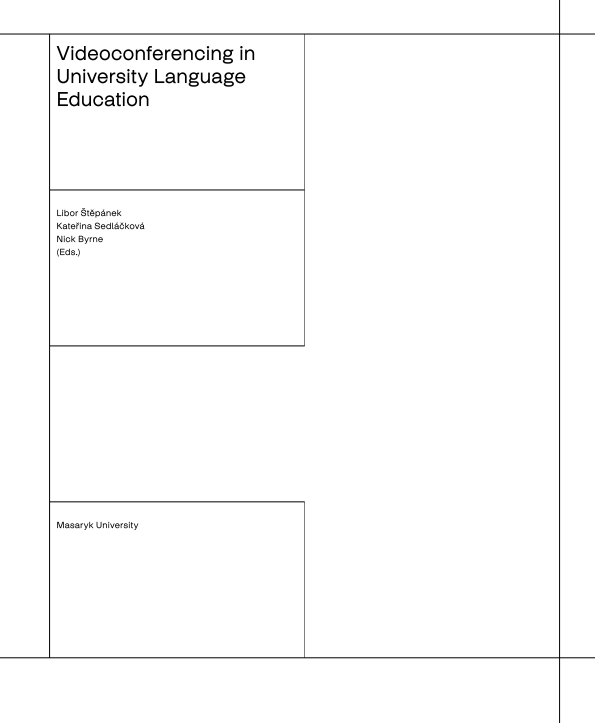
In the early days before smart phones, social media, and iPads, TESL teachers at AU were divided into two camps in their ideas of IT in language classes – those who were comfortable with modern technology and those who were concerned cables, cameras and screens would negatively transform the learning/teaching environment. I sat somewhere in‑between but when, shortly after a Diverse Conference (Developing Innovative Visual Educational Resources for Students Everywhere), an enthusiastic teacher at MU asked me if I was interested in bringing our classes together via videoconference, enthusiasm surpassed concern and I became part of the techie group. Both of us agreed lectures and presentations were not something we wanted in our ‘undivided’ (or divided by distance only) classroom. We intended to create a unique environment where students could interact with each other and not use this unique VC environment for Q & As after a presentation or lecture.
More...
The authors take a sociopragmatic approach to their use of videoconferencing. The feedback from their programme reveals not only the linguistic challenges of using English as a Lingua Franca but also the socio-cultural challenges inherent in exchanges between students from different countries and cultural backgrounds as well as at different stages of linguistic and emotional development. The programme contributes to raising students’ awareness of related issues and practical workarounds. It also shows how videoconferencing can open an international window while maximising the reassurance of a familiar setting in order to minimise the shock of the new.
More...
The author outlines a detailed range of practical measures to ensure the success of using videoconferencing to develop research writing. The examples given highlight the technical challenges, but effective solutions and measures are presented. Clear parameters are listed and explained in using videoconferencing, and the importance of grounding parameters such as co-presence, visibility and audibility is stressed. The importance of establishing a community focus of support with both students and teachers can help with key issues of giving, receiving and acting on feedback. The article features detailed feedback from students on the effectiveness of the programme.
More...
The authors focus on the needs of geographically disperse researchers, who are able to gain a sense of community and increase their confidence through videoconferencing. The article gives practical advice and shows how writing research groups can be set up and best supported. This chapter also presents how language educators can play a flexible role in facilitating such a programme and addresses relevant technical issues and workarounds. Key points and options relating to structure, timing and frequency are discussed in detail.
More...
The author highlights the intercultural aspects of global online communication and how videoconferencing can be an effective tool for developing intercultural skills. Key to successful programme delivery is developing strategies which promote a wide range of skills: communication, teamwork, and cross-cultural navigation. Such skills are especially relevant for today’s globalised workplaces and globalised workforce. The importance of role giving, taking and sharing and the way these influence group dynamics are discussed.
More...
The author provides a detailed case study and reflective account of the aBerNo project. The course, making full use of videoconferencing, covered all four language learning skills through the teaching of key academic skills. The article covers key stages in the course’s development and highlights the work expected and outcomes achieved. Many technology-related issues are discussed, as are assessment procedures. The author provides a personal insight into the workings of a carefully developed project designed to enhance both the linguistic and academic skills of high-level students.
More...
The authors highlight the processes and outcomes of videoconferencing using an active participation approach. Two contrasting student groups at different universities were able to participate in a varied programme of tasks using creativity to improve socio-linguistic skills. The course was task-orientated, with the learners generating or sourcing the majority of materials. A mix of the theoretical and the practical was used to underpin the programme.
More...
The author looks at key issues facing managers in establishing effective videoconferencing courses in higher education. The issues highlighted are of a practical nature, but ones which cannot be ignored by those in charge of managing resources, including creating the right physical space, looking at timing and intercultural questions, and making proper use of both physical and human resources. This chapter provides an overview and helpful checklist to maximise the added value and quality of courses for all stakeholders.
More...
This quick guide is a compilation of two videoconferencing booklets created for the Invite and Compact projects in 2008 and 2011, respectively. The aim of this guide is to inspire novice videoconference practitioners to deal with basic videoconferencing situations and challenges in an effective way.
More...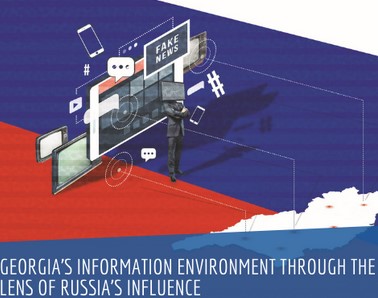
The developments following the 2020 U.S. presidential election, which took place during the writing of this chapter, have once more highlighted the problem of societal polarisation, information manipulation, and the influence of new information technologies on societies’ political decision-making and real-time behaviour. The 2021 storming of the U.S. Capitol, ‘the most recognized symbol of democratic governance in the world’, brought to fore questions around the collective responsibility of citizens, politicians, and tech giants to better understand, protect, and exercise freedom of speech in a time of disinformation. For example: What constitutes ‘harmful’ online content? Where does the border lie between online content that is protected by the right to freedom of expression and online content that should, or needs to, be regulated? Should tech giants be liable for the information they host? Do they have different obligations to society than other private companies do?
More...
Cybersecurity is one of the new dimensions of security, the one responsible for ensuring a secure online space, a space which can be used safely in all areas of people’s lives - from finance to social media, education, economy, politics, information, debate and even military. Because over 50% of the population is connected in 2020 to the internet, both for work and personal purposes, as numerous transactions are being registered in the cyberspace every second, government and private sector alike need to work together to secure this space to develop early-warning systems and protect the IT infrastructure of any kind of attacks. There are tools for measuring and monitoring cyber-attacks, which need to be explored and constantly improved. But this is not enough as the use of these tools needs to be completed by the joint efforts in raising the users’ awareness in protecting against any attacks. Additionally, exploring and taking advantage of the benefits a digital economy and society can offer should be supported by investments in education and training while maintaining an updated and secure infrastructure.
More...